Obtainment and Characterization of Metal-Coated Polyethylene Granules as a Basis for the Development of Heat Storage Systems
Abstract
:1. Introduction
2. Materials and Methods
2.1. Activation of the Polymer Surface
2.2. Metallization of Activated Polyethylene Granules and Study of Its Kinetics
2.3. Test Methods
2.4. Experimental Setup Simulating the Heat Accumulator Operation
3. Results and Discussion
3.1. Activation of Polyethylene Granules
3.2. Metallization of Polyethylene Granules
3.3. Efficiency of Using Metallized Polyethylene as a Basis for the Creation of Phase Transition Heat Storage Systems
4. Conclusions
Author Contributions
Funding
Institutional Review Board Statement
Informed Consent Statement
Data Availability Statement
Acknowledgments
Conflicts of Interest
References
- Nabiyev, A.A.; Olejniczak, A.; Islamov, A.K.; Pawlukojc, A.; Ivankov, O.I.; Balasoiu, M.; Zhigunov, A.; Nuriyev, M.A.; Guliyev, F.M.; Soloviov, D.V.; et al. Composite Films of HDPE with SiO2 and ZrO2 Nanoparticles: The Structure and Interfacial Effects. Nanomaterials 2021, 11, 2673. [Google Scholar] [CrossRef]
- Słota, D.; Florkiewicz, W.; Piętak, K.; Szwed, A.; Włodarczyk, M.; Siwińska, M.; Rudnicka, K.; Sobczak-Kupiec, A. Preparation, Characterization, and Biocompatibility Assessment of Polymer-Ceramic Composites Loaded with Salvia officinalis Extract. Materials 2021, 14, 6000. [Google Scholar] [CrossRef]
- Dolza, C.; Fages, E.; Gonga, E.; Gomez-Caturla, J.; Balart, R.; Quiles-Carrillo, L. Development and Characterization of Environmentally Friendly Wood Plastic Composites from Biobased Polyethylene and Short Natural Fibers Processed by Injection Moulding. Polymers 2021, 13, 1692. [Google Scholar] [CrossRef]
- Levytskyi, V.; Katruk, D.; Masyuk, A.; Bialopiotrowicz, T.; Bratychak, M.; Chopyk, N. The effect of poly(Vinyl Chloride) modifier and filler nature on properties of polyester composites. Chem. Chem. Technol. 2018, 12, 53–57. [Google Scholar] [CrossRef]
- Levytskyi, V.Y.; Masyuk, A.S.; Suberlyak, O.V. Preparation and properties of polymer-silicate composites based on hydrophilic polymers. Vopr. Khimii Khimicheskoi Tekhnologii 2017, 6, 68–74. [Google Scholar]
- Masyuk, A.S.; Kysil, K.V.; Katruk, D.S.; Skorokhoda, V.Y.; Bilyi, L.M.; Humenetskyi, T.V. Elastoplastic Properties of Polylactide Composites with Finely Divided Fillers. Mater. Sci. 2020, 56, 319–326. [Google Scholar] [CrossRef]
- Levytskyj, V.; Laruk, Y.; Humenetsky, T.; Sikora, J. The influence of polystyrene modifier and plasticizer nature on the properties of poly(vinyl chloride). Chem. Chem. Technol. 2015, 9, 199–203. [Google Scholar] [CrossRef]
- Krasinskyi, V.; Kochubei, V.; Klym, Y.; Suberlyak, O. Thermogravimetric research into composites based on the mixtures of polypropylene and modified polyamide. East. Eur. J. Enterp. Technol. 2017, 4, 44–50. [Google Scholar] [CrossRef]
- Krasinskyi, V.; Dulebová, L.; Suberlyak, O.; Spišák, E.; Pankiv, M. Analysis of the influence of intercalated montmorillonite on homogenization of PP/PA-6 nanocomposite in melt. MM Sci. J. 2021, 4275–4282. [Google Scholar] [CrossRef]
- Katruk, D.; Levytskyi, V.; Khromyak, U.; Moravskyi, V.; Masyuk, A. Physicochemical principles of synthesis and modification of unsaturated polyester-polyvinyl chloride composites and the properties of materials derived from them. Int. J. Polym. Sci. 2019, 2019, 2547384. [Google Scholar] [CrossRef]
- Saeed, A.; Zaaba, N.; Ismeel, H. A Review: Metal Filled Thermoplastic Composites. Polym. Plast. Technol. Mater. 2021, 60, 1033–1050. [Google Scholar] [CrossRef]
- Ilyas, R.A.; Sapuan, S.M.; Asyraf, M.R.M.; Dayana, D.A.Z.N.; Amelia, J.J.N.; Rani, M.S.A.; Norrrahim, M.N.F.; Nurazzi, N.M.; Aisyah, H.A.; Sharma, S.; et al. Polymer Composites Filled with Metal Derivatives: A Review of Flame Retardants. Polymers 2021, 13, 1701. [Google Scholar] [CrossRef]
- Grytsenko, O.; Pukach, P.; Suberlyak, O.; Shakhovska, N.; Karovič, V., Jr. Usage of Mathematical Modeling and Optimization in Development of Hydrogel Medical Dressings Production. Electronics 2021, 10, 620. [Google Scholar] [CrossRef]
- Hussain, L.B.; Ismail, H.; Mariatti, M. Metal Filled High Density Polyethylene Composites—Electrical and Tensile Properties. J. Thermoplast. Compos. Mater. 2006, 19, 413–425. [Google Scholar] [CrossRef]
- Sonoda, K.; Moriya, Y.; Jantunen, H. Dielectric property of Cu powder/polymer composites. Mater. Sci. Pol. 2011, 29, 63–69. [Google Scholar] [CrossRef]
- Grytsenko, O.M.; Naumenko, O.P.; Suberlyak, O.V.; Dulebova, L.; Berezhnyy, B.V. Optimization of the technological parameters of the graft copolymerization of 2-hydroxyethyl methacrylate with polyvinylpyrrolidone for nickel deposition from salts. Vopr. Khimii Khimicheskoi Tekhnologii 2020, 1, 25–32. [Google Scholar] [CrossRef]
- Grytsenko, O.M.; Pukach, P.Y.; Suberlyak, O.V.; Moravskyi, V.S.; Kovalchuk, R.A.; Berezhnyy, B.V. The scheffe’s method in the study of mathematical model of the polymeric hydrogels composite structures optimization. Math. Modeling Comput. 2019, 6, 258–267. [Google Scholar] [CrossRef]
- Levyts’kyi, V.E.; Masyuk, A.S.; Bialopiotrowicz, T.; Bilyi, L.M.; Humenets’kyi, T.V. Morphology and Properties of Thermoplastic Composites with Modified Silicate Fillers. Mater. Sci. 2018, 54, 48–54. [Google Scholar] [CrossRef]
- Suberlyak, O.V.; Hrytsenko, O.M.; Hishchak, K.Y. Influence of the Metal Surface of Powder Filler on the Structure and Properties of Composite Materials Based on the Copolymers of Methacrylates with Polyvinylpyrrolidone. Mater. Sci. 2016, 52, 155–164. [Google Scholar] [CrossRef]
- Suberlyak, O.; Grytsenko, O.; Hischak, K.; Hnatchuk, N. Research of influence of the metal nature on the mechanism of polyvinylpyrrolidone metal copolymers synthesis. Chem. Chem. Technol. 2013, 7, 289–294. [Google Scholar] [CrossRef]
- Camargo, P.H.C.; Satyanarayana, K.G.; Wypych, F. Nanocomposites: Synthesis, Structure, Properties and New Application Opportunities. Mater. Res. 2009, 12, 1–39. [Google Scholar] [CrossRef] [Green Version]
- Lanzl, L.; Wudy, K.; Greiner, S.; Drummer, D. Selective laser sintering of copper filled polyamide 12: Characterization of powder properties and process behavior. Polym. Compos. 2019, 40, 1801–1809. [Google Scholar] [CrossRef]
- Timbs, K.; Khatamifar, M.; Antunes, E.; Lin, W. Experimental study on the heat dissipation performance of straight and oblique fin heat sinks made of thermal conductive composite polymers. Therm. Sci. Eng. Prog. 2021, 22, 100848. [Google Scholar] [CrossRef]
- Trojanowska-Tomczak, M.; Steller, R.; Janukiewicz, J.; Ziaja, J.; Szafran, G. Conductive composites of PVC and wood's metal with interpenetrating network structure. J. Appl. Polym. Sci. 2013, 129, 3536–3545. [Google Scholar] [CrossRef]
- Alrashed, M.; Alhassan, S. A facile approach towards glassy-metals/polymer composites. Mater. Chem. Phys. 2021, 257, 123731. [Google Scholar] [CrossRef]
- Amoabeng, D.; Velankar, S. A review of conductive polymer composites filled with low melting point metal alloys. Polym. Eng. Sci. 2017, 58, 1010–1019. [Google Scholar] [CrossRef] [Green Version]
- Amoabeng, D.; Velankar, S.S. Bulk Soldering:Conductive Polymer Composites filled with copper particles and solder. Colloids Surf. A Physicochem. Eng. Asp. 2018, 553, 624–632. [Google Scholar] [CrossRef]
- Xia, H.; Zou, M.; Lei, Y.; He, J.; Zhang, F.; Liu, T.; Li, M.; Liang, D. Effects of the total content of eutectic Sn-Cu alloy and Cu particles used as conductive filler on the structure and properties of polyamide-66 composites. J. Polym. Res. 2018, 25, 176. [Google Scholar] [CrossRef]
- Li, H.; Jiang, M.; Dong, L.; Xie, H.; Xiong, C. Particle Size Dependence of the Dielectric Properties of Polyvinyledene Fluoride/Silver Composites. J. Macromol. Sci. 2013, 52, 1058–1066. [Google Scholar] [CrossRef]
- Bigg, D.M. Mechanical and conductive properties of metal fibre-filled polymer composites. Composites 1979, 10, 95–100. [Google Scholar] [CrossRef]
- Kucherenko, A.; Nikitchuk, O.; Baran, N.; Dulebova, L.; Kuznetsova, M.; Moravskyi, V. Characteristics of Metallized Polymeric Raw Materials. In Proceedings of the 2021 IEEE 11th International Conference Nanomaterials: Applications & Properties (NAP), Odessa, Ukraine, 5–11 September 2021. [Google Scholar] [CrossRef]
- Jiang, D.; Murugadoss, V.; Wang, Y.; Lin, J.; Ding, T.; Wang, Z.; Shao, Q.; Wang, C.; Liu, H.; Lu, N.; et al. Electromagnetic Interference Shielding Polymers and Nanocomposites—A Review. Polym. Rev. 2019, 59, 280–337. [Google Scholar] [CrossRef]
- Kumar, P.; Narayan Maiti, U.; Sikdar, A.; Kumar Das, T.; Kumar, A.; Sudarsan, V. Recent Advances in Polymer and Polymer Composites for Electromagnetic Interference Shielding: Review and Future Prospects. Polym. Rev. 2019, 59, 687–738. [Google Scholar] [CrossRef]
- Los, P.; Lukomska, A.; Jeziorska, R. Metal-polymer composites for electromagnetic interference shielding applications. Polimery 2021, 61, 663–669. [Google Scholar] [CrossRef]
- Vadivelu, M.A.; Kumar, C.R.; Joshi, G.M. Polymer composites for thermal management: A review. Compos. Interfaces 2016, 23, 847–872. [Google Scholar] [CrossRef]
- Huang, Y.; Ellingford, C.; Bowen, C.; McNally, T.; Wu, D.; Wan, C. Tailoring the electrical and thermal conductivity of multi-component and multi-phase polymer composites. Int. Mater. Rev. 2020, 65, 129–163. [Google Scholar] [CrossRef]
- Hansson, J.; Nilsson, T.M.J.; Ye, L.; Liu, J. Novel nanostructured thermal interface materials: A review. Int. Mater. Rev. 2017, 63, 22–45. [Google Scholar] [CrossRef]
- Misiura, A.I.; Mamunya, Y.P.; Kulish, M.P. Metal-Filled Epoxy Composites: Mechanical Properties and Electrical/Thermal Conductivity. J. Macromol. Sci. Part B 2019, 59, 121–136. [Google Scholar] [CrossRef]
- Shaqsi, A.Z.; Sopian, K.; Al-Hinai, A. Review of energy storage services, applications, limitations, and benefits. Energy Rep. 2020, 6, 288–306. [Google Scholar] [CrossRef]
- Fernández, A.I.; Barreneche, C.; Miró, L.; Brückner, S.; Cabeza, L.F. 22—Waste heat recovery using thermal energy storage. In Woodhead Publishing Series in Energy, Advances in Thermal Energy Storage Systems, 2nd ed.; Cabeza, L.F., Ed.; Woodhead Publishing: Sawston, UK, 2021; pp. 639–653. [Google Scholar] [CrossRef]
- Atinafu, D.G.; Ok, Y.S.; Kua, H.W.; Kim, S. Thermal properties of composite organic phase change materials (PCMs): A critical review on their engineering chemistry. Appl. Therm. Eng. 2020, 181, 115960. [Google Scholar] [CrossRef]
- Hussain, F.; Rahman, M.Z.; Sivasengaran, A.N.; Hasanuzzaman, M. Chapter 6—Energy storage technologies. In Energy for Sustainable Development; Hasanuzzaman, M.D., Rahim, N.A., Eds.; Academic Press: Cambridge, MA, USA, 2020; pp. 125–165. [Google Scholar] [CrossRef]
- Yan, D.; Ming, W.; Liu, S.; Yin, G.; Zhang, Y.; Tang, B.; Zhang, S. Polyethylene glycol (PEG)/silicon dioxide grafted aminopropyl group and carboxylic multi-walled carbon nanotubes (SAM) composite as phase change material for light-to-heat energy conversion and storage. J. Energy Storage 2021, 36, 102428. [Google Scholar] [CrossRef]
- Zauner, C.; Hengstberger, F.; Etzel, M.; Lager, D.; Hofmann, R.; Walter, H. Experimental characterization and simulation of a fin-tube latent heat storage using high density polyethylene as PCM. Appl. Energy 2016, 179, 237–246. [Google Scholar] [CrossRef]
- Sheikholeslami, M.; Jafaryar, M.; Shafee, A.; Babazadeh, H. Acceleration of discharge process of clean energy storage unit with insertion of porous foam considering nanoparticle enhanced paraffin. J. Clean. Prod. 2020, 261, 121206. [Google Scholar] [CrossRef]
- Li, Z.; Shahsavar, A.; Al-Rashed, A.; Talebizadehsardari, P. Effect of porous medium and nanoparticles presences in a counter-current triple-tube composite porous/nano-PCM system. Appl. Therm. Eng. 2020, 167, 114777. [Google Scholar] [CrossRef]
- Sciacovelli, A.; Gagliardi, F.; Verda, V. Maximization of performance of a PCM latent heat storage system with innovative fins. Appl. Energy 2015, 137, 707–715. [Google Scholar] [CrossRef]
- Sharma, R.K.; Ganesan, P.; Tyagi, V.V.; Metselaar, H.S.C.; Sandaran, S.C. Developments in organic solid–liquid phase change materials and their applications in thermal energy storage. Energy Convers. Manag. 2015, 95, 193–228. [Google Scholar] [CrossRef] [Green Version]
- Chu, Y.-M.; Abu-Hamdeh, N.H.; Ben-Beya, B.; Hajizadeh, M.; Li, Z.; Bach, Q.-V. Nanoparticle enhanced PCM exergy loss and thermal behavior by means of FVM. J. Mol. Liq. 2020, 320, 114457. [Google Scholar] [CrossRef]
- Arıcı, M.; Tütüncü, E.; Yıldız, Ç.; Li, D. Enhancement of PCM melting rate via internal fin and nanoparticles. Int. J. Heat Mass Transf. 2020, 156, 119845. [Google Scholar] [CrossRef]
- Iachachene, F.; Haddad, Z.; Oztop, H.F.; Abu-Nada, E. Melting of phase change materials in a trapezoidal cavity: Orientation and nanoparticles effects. J. Mol. Liq. 2019, 292, 110592. [Google Scholar] [CrossRef]
- Hajizadeh, M.R.; Alsabery, A.I.; Sheremet, M.A.; Kumar, R.; Li, Z.; Bach, Q.-V. Nanoparticle impact on discharging of PCM through a thermal storage involving numerical modeling for heat transfer and irreversibility. Powder Technol. 2020, 376, 424–437. [Google Scholar] [CrossRef]
- Kucherenko, A.N.; Moravskyi, V.S.; Kuznetsova, M.Y.; Grytsenko, O.N.; Masyuk, A.S.; Dulebova, L. Regularities of Obtaining Metal-Filled Polymer Composites. In Nanomaterials in Biomedical Application and Biosensors (NAP-2019); Pogrebnjak, A., Pogorielov, M., Viter, R., Eds.; Springer Proceedings in Physics; Springer: Singapore, 2020; Volume 244, pp. 59–66. [Google Scholar] [CrossRef]
- Moravskyi, V.; Kucherenko, A.; Kuznetsova, M.; Dulebova, L.; Spišák, E.; Majerníková, J. Utilization of Polypropylene in the Production of Metal-Filled Polymer Composites: Development and Characteristics. Materials 2020, 13, 2856. [Google Scholar] [CrossRef]
- Moravskyi, V.; Kucherenko, A.; Kuznetsova, M.; Dziaman, I.; Grytsenko, O.; Dulebova, L. Studying the effect of concentration factors on the process of chemical metallization of powdered polyvinylchloride. East. Eur. J. Enterp. Technol. 2018, 3, 40–47. [Google Scholar] [CrossRef] [Green Version]
- Moravskyi, V.; Dziaman, I.; Suberliak, S.; Kuznetsova, M.; Tsimbalista, T.; Dulebova, L. Research into kinetic patterns of chemical metallization of powderlike polyvinylchloride. East. Eur. J. Enterp. Technol. 2017, 4, 50–57. [Google Scholar] [CrossRef]
- Moravskyi, V.; Dziaman, I.; Suberliak, S.; Grytsenko, O.; Kuznetsova, M. Features of the production of metal-filled composites by metallization of polymeric raw materials. In Nanomaterials: Application & Properties, Proceedings of the 7th International Conference Nanomaterials: Application & Properties (NAP), Zatoka, Ukraine, 10–15 September 2017; IEEE: Odessa, Ukraine, 2017. [Google Scholar] [CrossRef]
- Kucherenko, A.; Nikitchuk, O.; Dulebova, L.; Moravskyi, V. Activation of polyethylene granules by finely dispersed zinc. Chem. Technol. Appl. Subst. 2021, 4, 191–197. [Google Scholar] [CrossRef]
- Shalkauskas, M.; Vashkyalis, A. Chemical Metallization of Plastics; Khimiya: Sankt Petersburg, Russia, 1985. (In Russian) [Google Scholar]
- WAXSFIT—Analysis of X-RAY Diffraction Curves. Available online: http://www2.ath.bielsko.pl/~mrabiej/waxsfit/sub/main_en/ (accessed on 7 December 2021).

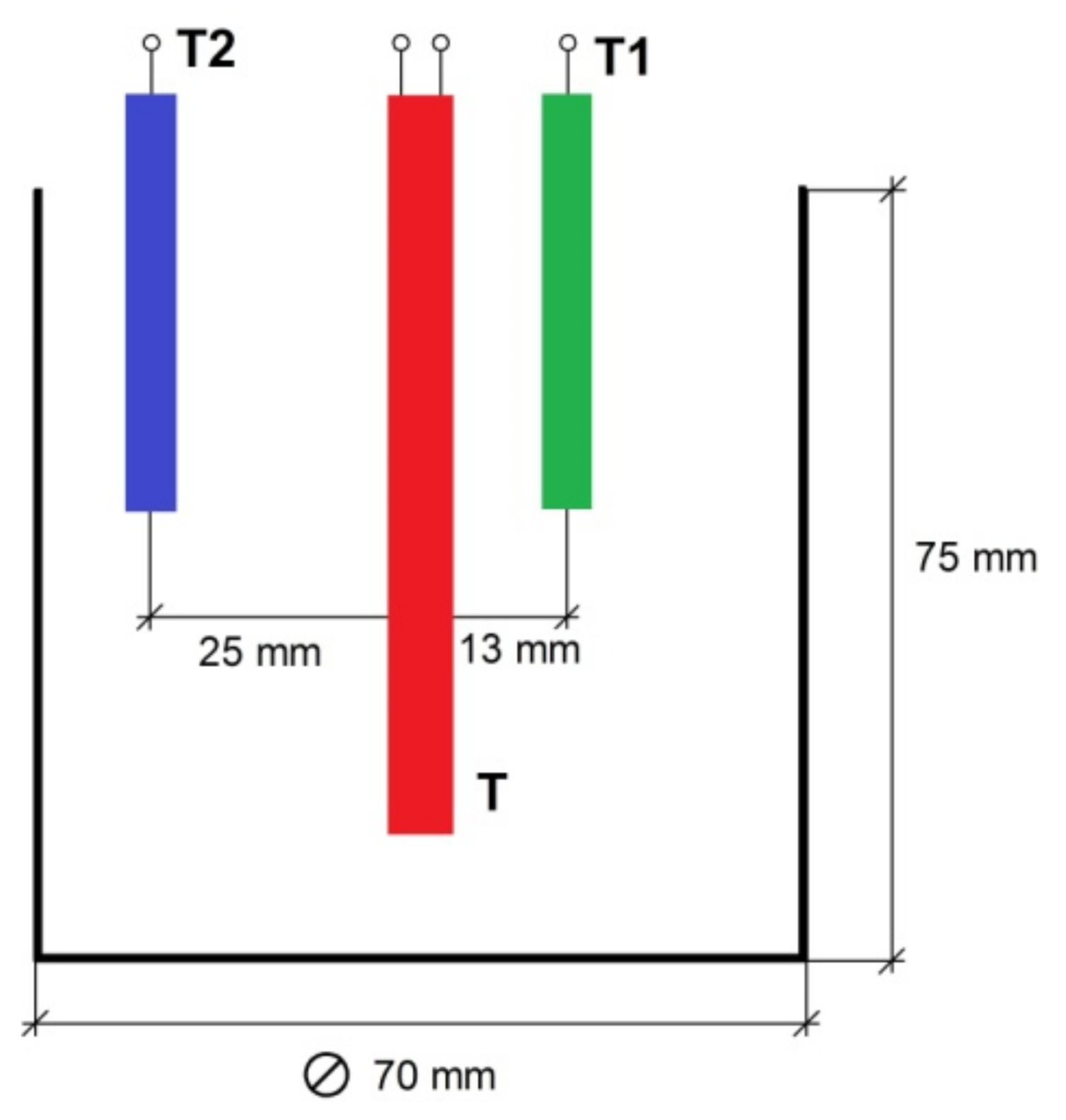

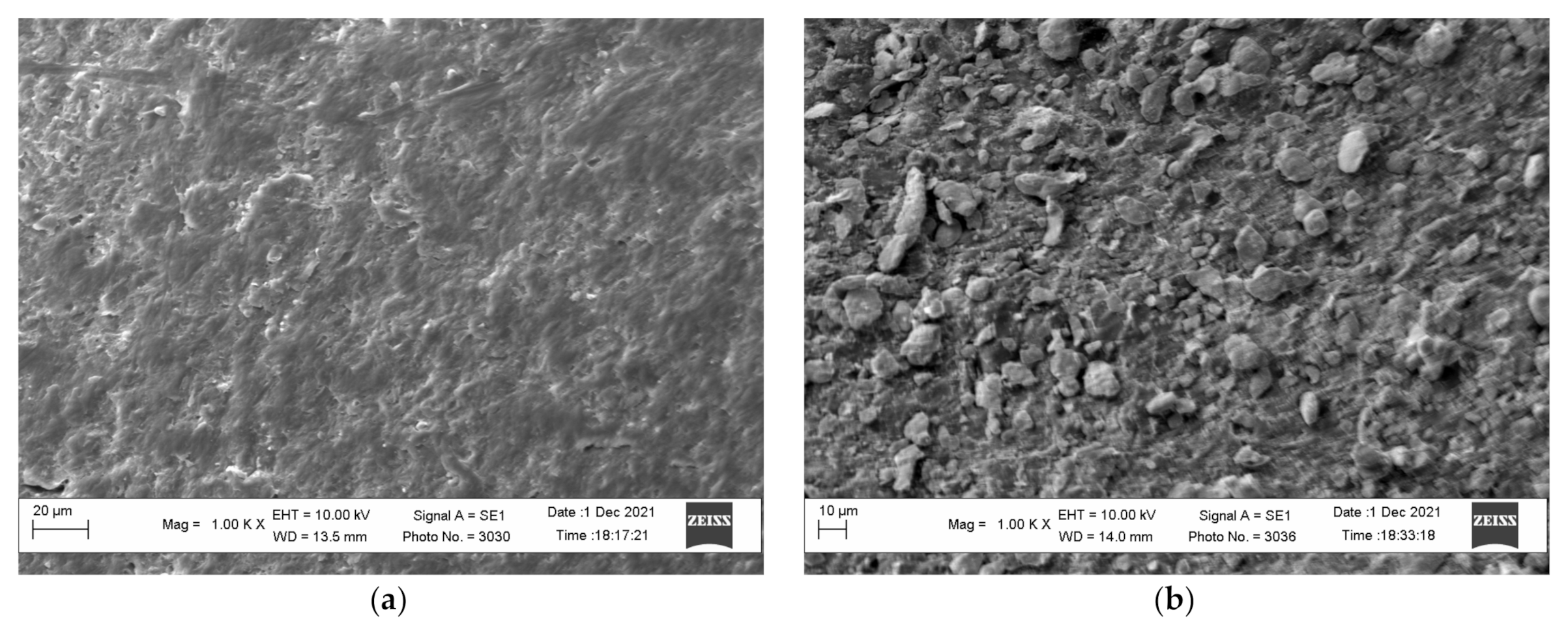

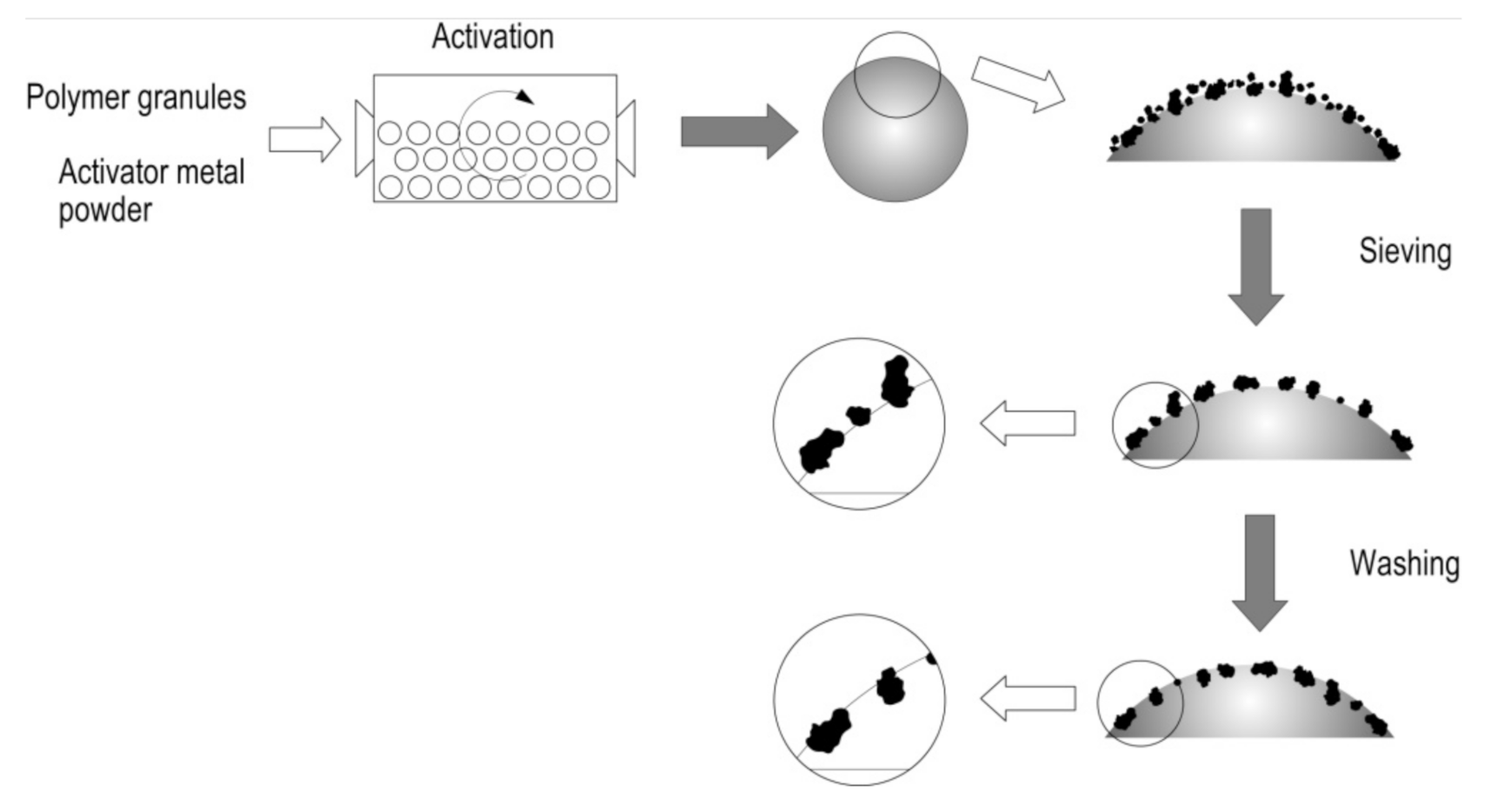
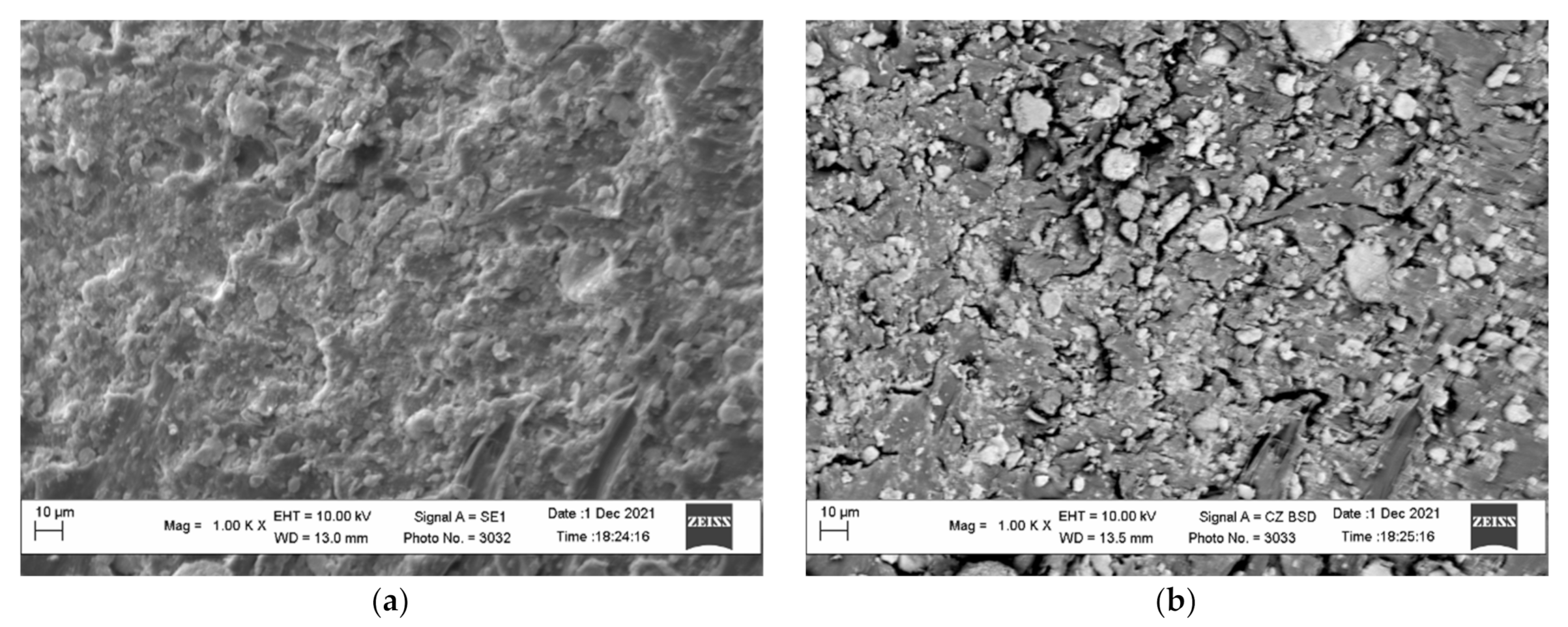

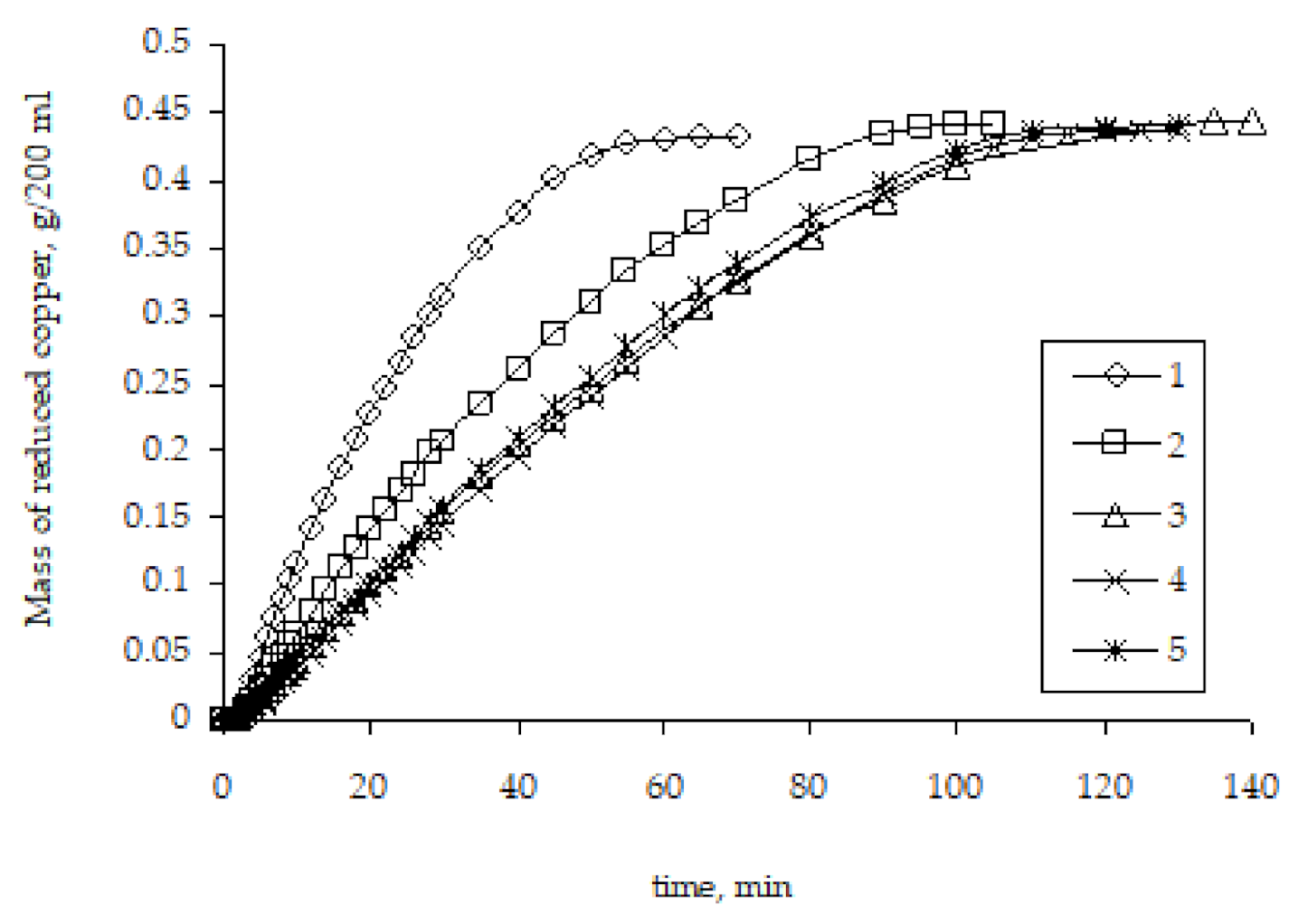

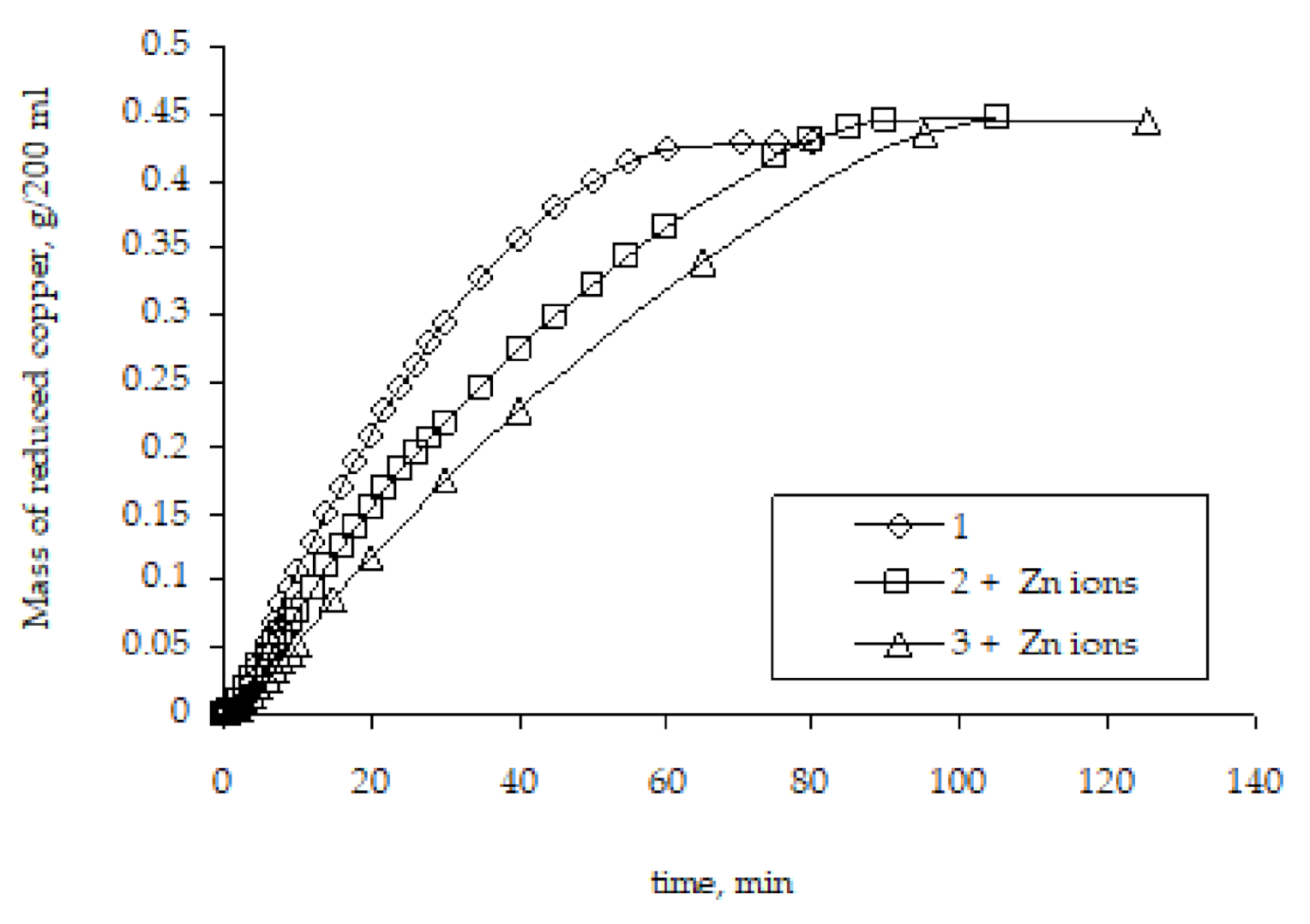

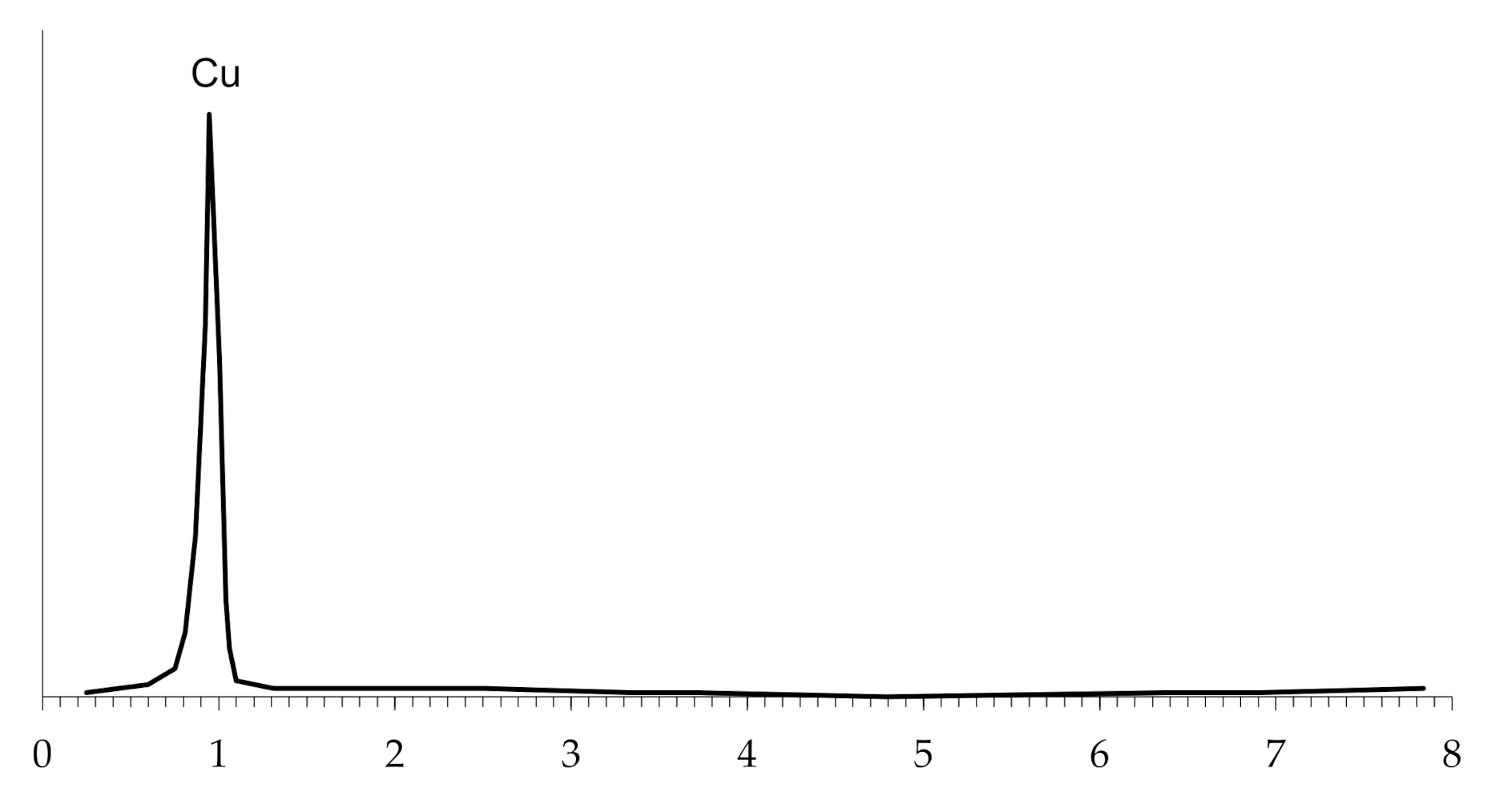

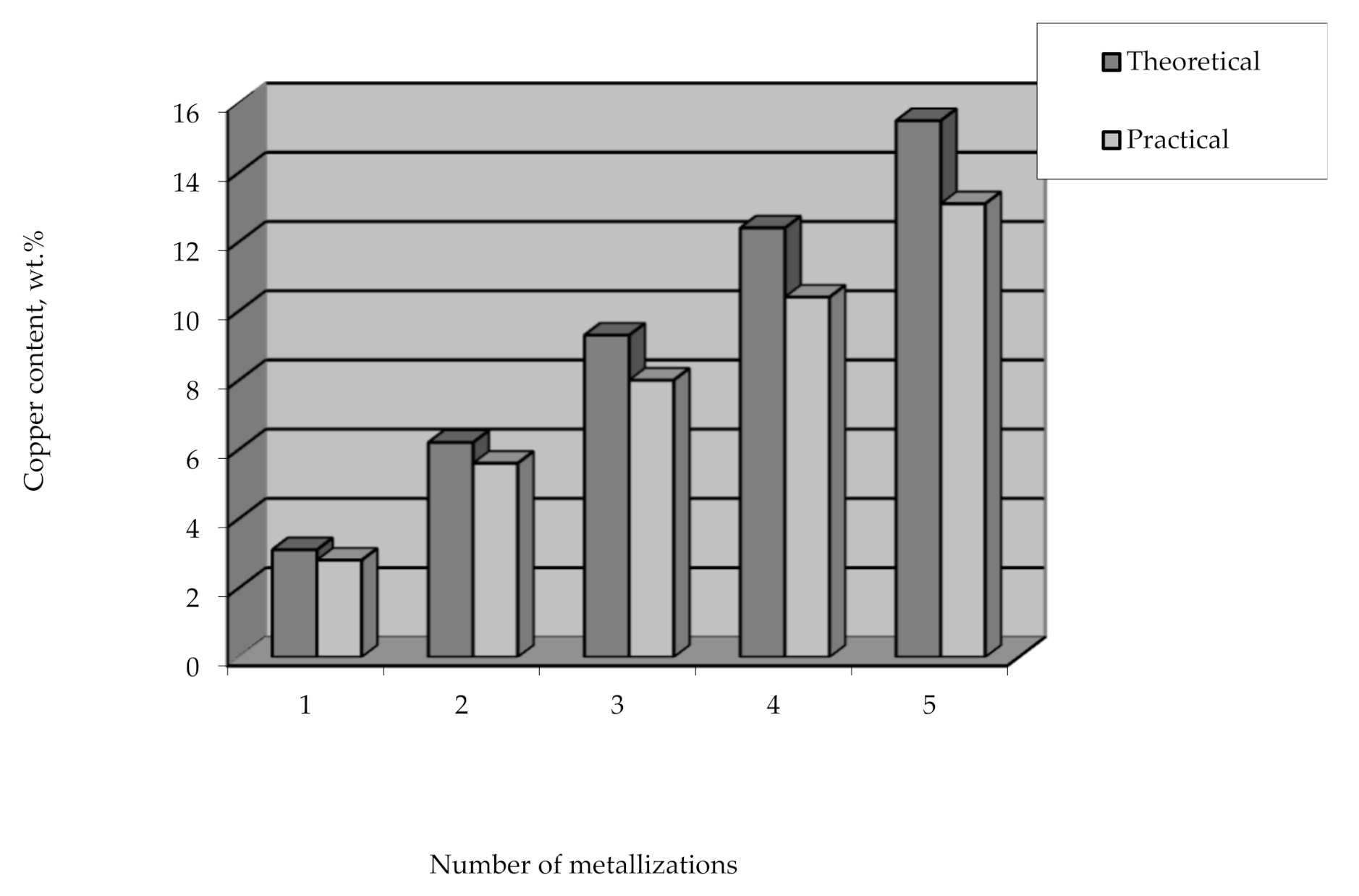

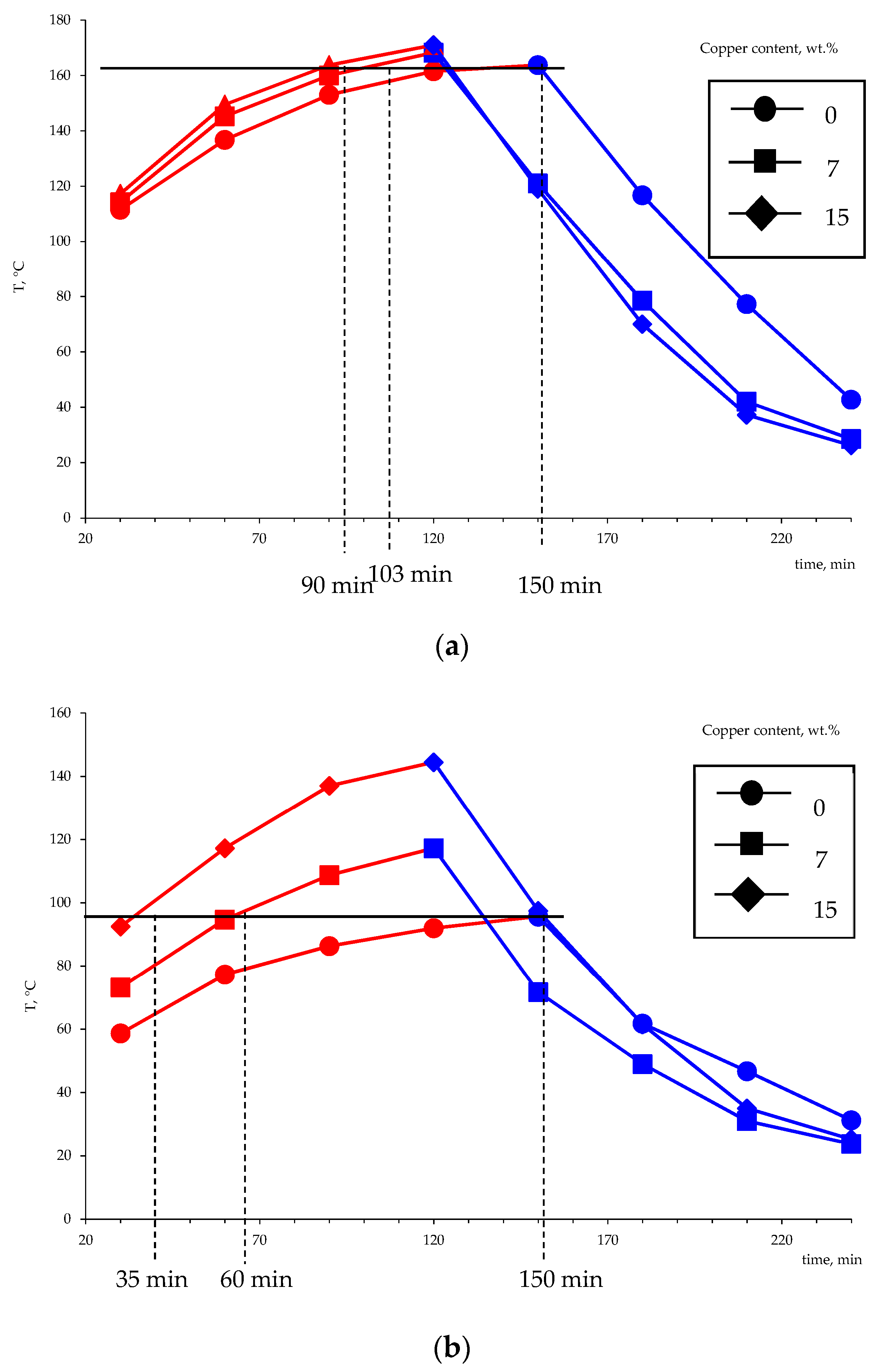
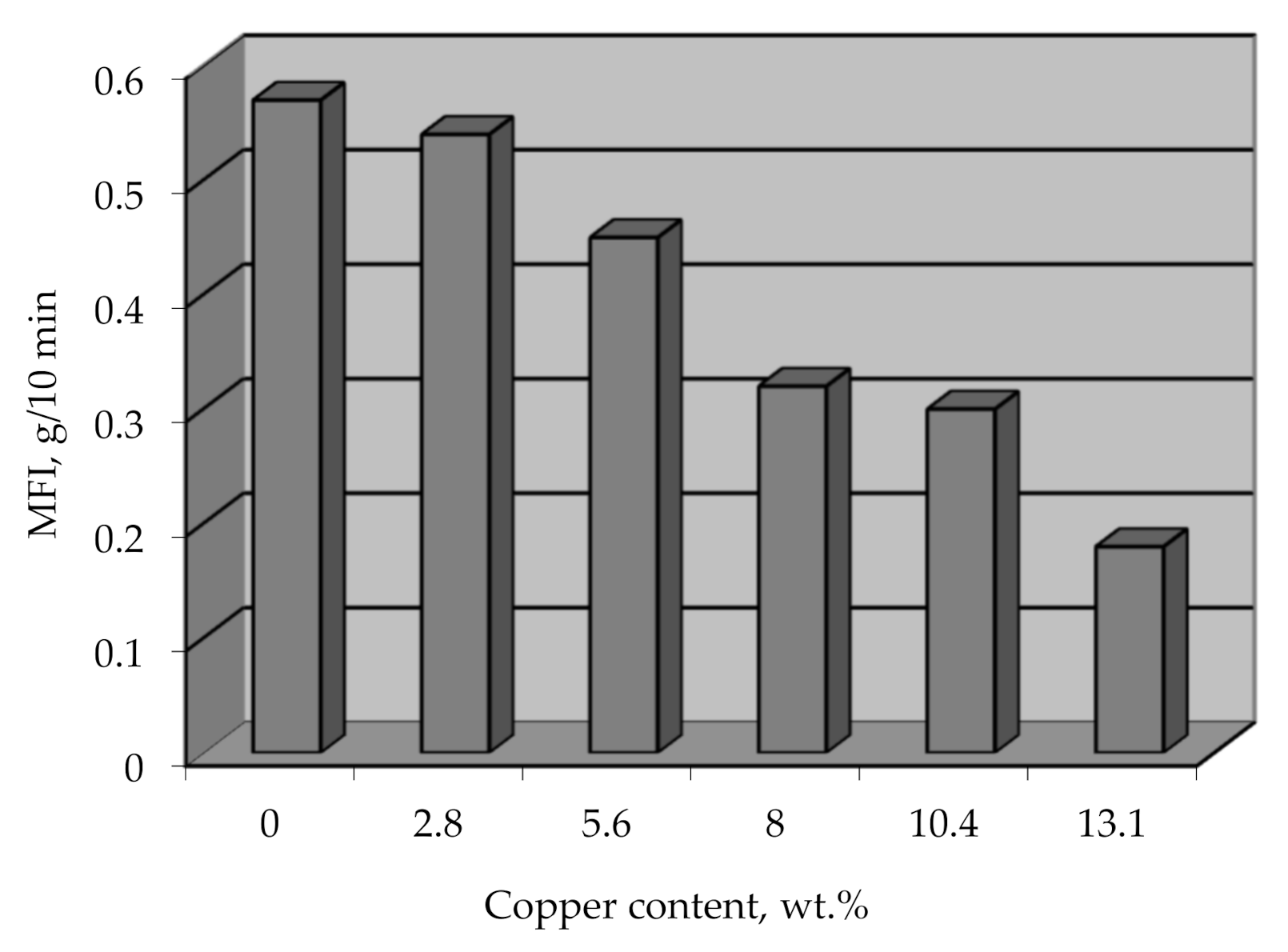
Publisher’s Note: MDPI stays neutral with regard to jurisdictional claims in published maps and institutional affiliations. |
© 2022 by the authors. Licensee MDPI, Basel, Switzerland. This article is an open access article distributed under the terms and conditions of the Creative Commons Attribution (CC BY) license (https://creativecommons.org/licenses/by/4.0/).
Share and Cite
Moravskyi, V.; Kucherenko, A.; Kuznetsova, M.; Dulebova, L.; Spišák, E. Obtainment and Characterization of Metal-Coated Polyethylene Granules as a Basis for the Development of Heat Storage Systems. Polymers 2022, 14, 218. https://doi.org/10.3390/polym14010218
Moravskyi V, Kucherenko A, Kuznetsova M, Dulebova L, Spišák E. Obtainment and Characterization of Metal-Coated Polyethylene Granules as a Basis for the Development of Heat Storage Systems. Polymers. 2022; 14(1):218. https://doi.org/10.3390/polym14010218
Chicago/Turabian StyleMoravskyi, Volodymyr, Anastasiia Kucherenko, Marta Kuznetsova, Ludmila Dulebova, and Emil Spišák. 2022. "Obtainment and Characterization of Metal-Coated Polyethylene Granules as a Basis for the Development of Heat Storage Systems" Polymers 14, no. 1: 218. https://doi.org/10.3390/polym14010218





